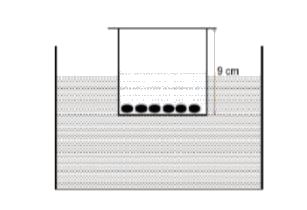Two circularly shaped linear polarisers are placed coaxially. The transmission axis of the first polarizer is at 30∘ from the vertical while the second one is at 60∘, both in the clockwise sense. If an unpolarised beam of light of intensity I=20W/m2 is incident on this pair of polarisers, then the intensities I1 and I2 transmitted by the first and the second polarisers, respectively, will be close to
I1=10.0W/m2 and I2=7.5W/m2
I1=20.0W/m2 and I2=15W/m2
I1=10.0W/m2 and I2=8.6W/m2
I1=15.0W/m2 and I2=0.0W/m2
The correct Answer is:A
Step by step video, text & image solution for Two circularly shaped linear polarisers are placed coaxially. The transmission axis of the first polarizer is at 30^(@) from the vertical while the second one is at 60^(@), both in the clockwise sense. If an unpolarised beam of light of intensity I = 20 W//m^(2) is incident on this pair of polarisers, then the intensities I_(1) and I_(2) transmitted by the first and the second polarisers, respectively, will be close to by Physics experts to help you in doubts & scoring excellent marks in Class 12 exams.
Topper's Solved these Questions
Similar Questions
A wide bottom cylindrical massless plastic container of height 9 cm has 40 identical coins inside it and is floating on water with 3 cm inside the water. If we start putting more of such coins on its lid. It is observed that after N coins are put, its equilibrium changes from stable to unstable. Equilibrium in floating is stable if the geometric center of the submerged portion is above the center of mass of the object) The value of N is closed to
 04:55View Solution
04:55View SolutionA mixture of plane polarised and unpolarised light falls normally on a polarising sheet. On rotating the polarising sheet about the direction of the incident beam, the transmitted intensity varies by a factor 4. Find the ratio of the intensities I_(P) and I_(0) respectively of the polarized and unpolarised components in the incident beam. Next the axis of polarising sheet is fixed at an angle of 45^(@) with the direction when the transmitted intensity is maximum. Then obtain the total intensity of the transmitted beam in terms of I_(0) . [(3)/(2),(5I_(0))/(4)]
09:49View SolutionThree circularly shaped linear polarisers are placed coaxially. The transmission axis of the first polariser is at 30^(@) , the second one is at 60^(@) and the third at 90^(@) to the vertical all in the clockwise sense. Each polariser additionally absorbs 10% of the light. If a vertically polarised beam of light of intensity I = 100 W//m^(2) is incident on this assembly of polarisers, then the final intensity of the transmitted light will be close to
02:29View SolutionThe polariser and analyser are inclined to each other at 60∘. The intensity of polarised light emerging from polariser is I. The intensity of the unpolarised light incident on the polariser is
04:13View SolutionA unpolarised light is passed through 3 polarisers. If the second polariser is at an angle 30∘ with the first and the third polariser is at an angle 60∘ with the second. Find the final intensity of the light passed through this combination in initial intensity was I.
02:29View SolutionThe polariser and analyser are inclined to each other at 60^(@) . The intensity of polarised light emerging from polariser is I. The intensity of the unpolarised light incident on the polariser is
View SolutionQuestions 124 and 125 are based on paragraph given below: Unpolarised light of intensity 32 W m−2 passes through three polarisers such that transmission axis of last polariser is crossed with first, the intensity of emergent light is 3 Wm−2.
124. The nagle between transmission axis of first two polarisers is05:10View SolutionUnpolarised light of intensity 32Wm−2 passes through three polarisers such that the transmission axis of the last polariser is crossed with first. If the intensity of the emerging light is 3Wm−2, the angle between the axes of the first two polarisers is
03:50View SolutionThe polariser and analyser are inclined to each other at 60∘. If I/2 is the intensity of the polarised light emergent from analyser. Then the intensity of the unpolarised light incident on the polariser is
View SolutionUnpolarised light of intensity 32 Wm^(-2) passes through three polarisers such that the transmission axis of the last polariser is crossed with first. It the intensity of the emerging light is 3Wm^(-2) , the angle between the axes of the first two polarisers is
03:50View SolutionThe polariser and analyser are inclined to each other at 60^(@) . If I/2 is the intensity of the polarised light emergent from analyser .Then the intensity of the unpolarised light incident on the polariser is
02:41View SolutionThe polariser and analyser are inclined to each other at 60^@ . The intensity of the polarised light emerging from the polariser is I . What is the intensity of the unpolarised light incident on the polariser ?
03:44View SolutionThe polariser and analyser are inclined to each other at 60∘. The intensity of polarised light emerging from polariser is I. The intensity of the unpolarised light incident on the polariser is
02:55View SolutionAn unpolarised light of intensity 64 Wm^(-2) passes through three polarisers such that the transmission axis of the last polariser is normal to first. If the intensity of emerging light is 6 Wm(-2),then angle between first two polariser may be
View SolutionAn unpolarised light of intensity I0 falls on a polarised whose optic axis is inclined at 45∘ to the incident light. Then the intensity of light emerging from the polarised is :
View Solution

